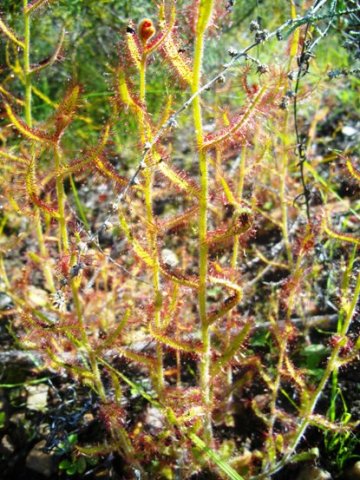Drosera cistiflora leaves

Author: Ivan Lätti
Photographer: Thabo Maphisa
The leaves of Drosera cistiflora constitute the unusual, even sinister feature of this plant. The leaves are visibly covered in sticky glands and reddish tentacles. Every tentacle has at its tip a glistening drop of mucilage resembling morning dew, giving cause for the sundew common name.
Oblong, green leaves with rounded tips sometimes form a ground-level rosette. There are always some narrow leaves spreading from the erect stems and flower stalks. The sweet mucilage secreted by the stalked glands on the leaves attracts insects. This mucilage contains a gummy substance functioning as an adhesive and enzymes for digesting captured insects. The glands, covering the leaves like dewdrops, can be moved by the plant's tentacles in response to arriving insect prey that may be digestible. Upon being touched, the tentacle bends towards the leaf centre, causing the possible food item to come into contact with more of the glands, improving the chances of a capture.
The thin tentacles bend towards the centre when touched by an intruder, holding on to insects landing on the leaves as best they can. There are further sessile glands on the leaves that absorb the nutrients yielded by captured insect bodies (Curtis-Scott, et al, 2020; Manning, 2009; KZN Wildlife Rhino Club News Oct 2010; iNaturalist).

